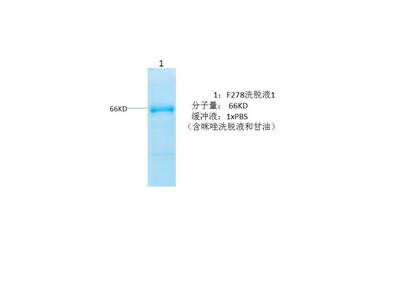Cyclin D1 protein
- Catalog No.:YD0121
- Applications:WB;SDS-PAGE
- Reactivity:Human
- Gene Name:
- CCND1
- Protein Name:
- Cyclin D1 protein
- Sequence:
- Amino acid: 9-138, with his-MBP tag.
- Human Gene Id:
- 595
- Human Swiss Prot No:
- P24385
- Mouse Swiss Prot No:
- P25322
- Formulation:
- Liquid in PBS
- Source:
- E.coli
- Dilution:
- WB 1:500-2000
- Concentration:
- SDS-PAGE >90%
- Storage Stability:
- -20°C/6 month,-80°C for long storage
- Other Name:
- G1/S-specific cyclin-D1 (B-cell lymphoma 1 protein) (BCL-1) (BCL-1 oncogene) (PRAD1 oncogene)
- Background:
- disease:A chromosomal aberration involving CCND1 may be a cause of B-lymphocytic malignancy, particularly mantle-cell lymphoma (MCL). Translocation t(11;14)(q13;q32) with immunoglobulin gene regions. Activation of CCND1 may be oncogenic by directly altering progression through the cell cycle.,disease:A chromosomal aberration involving CCND1 may be a cause of multiple myeloma [MIM:254500]. Translocation t(11;14)(q13;q32) with the IgH locus.,disease:A chromosomal aberration involving CCND1 may be a cause of parathyroid adenomas [MIM:168461]. Translocation t(11;11)(q13;p15) with the parathyroid hormone (PTH) enhancer.,function:Essential for the control of the cell cycle at the G1/S (start) transition.,online information:The Singapore human mutation and polymorphism database,PTM:Following DNA damage it is ubiquitinated by some SCF (SKP1-cullin-F-box) protein ligase complex containing FBXO31. Ubiquitination leads to its degradation and G1 arrest.,PTM:Phosphorylation at Thr-286 by MAP kinases is required for ubiquitination and degradation following DNA damage. It probably plays an essential role for recognition by the FBXO31 component of SCF (SKP1-cullin-F-box) protein ligase complex.,similarity:Belongs to the cyclin family.,similarity:Belongs to the cyclin family. Cyclin D subfamily.,subunit:Interacts with the CDK4 and CDK6 protein kinases to form a serine/threonine kinase holoenzyme complex. The cyclin subunit imparts substrate specificity to the complex.,
- Function:
- cell cycle checkpoint, DNA damage checkpoint, regulation of cyclin-dependent protein kinase activity, G1/S transition of mitotic cell cycle, mitotic cell cycle, re-entry into mitotic cell cycle, liver development, regulation of protein amino acid phosphorylation, positive regulation of protein amino acid phosphorylation, reproductive developmental process,protein amino acid phosphorylation, phosphorus metabolic process, phosphate metabolic process, response to DNA damage stimulus, ER-nuclear signaling pathway, response to unfolded protein, cell cycle, mitotic cell cycle checkpoint,cell surface receptor linked signal transduction, intracellular signaling cascade, regulation of mitotic cell cycle, sex differentiation, response to nutrient, positive regulation of cell proliferation, gonad development, male gonad development, response to radiation, response to UV, response to light stimulus,
- Subcellular Location:
- Nucleus . Cytoplasm . Nucleus membrane . Cyclin D-CDK4 complexes accumulate at the nuclear membrane and are then translocated to the nucleus through interaction with KIP/CIP family members. .
- June 19-2018
- WESTERN IMMUNOBLOTTING PROTOCOL
- June 19-2018
- IMMUNOHISTOCHEMISTRY-PARAFFIN PROTOCOL
- June 19-2018
- IMMUNOFLUORESCENCE PROTOCOL
- September 08-2020
- FLOW-CYTOMEYRT-PROTOCOL
- May 20-2022
- Cell-Based ELISA│解您多样本WB检测之困扰
- July 13-2018
- CELL-BASED-ELISA-PROTOCOL-FOR-ACETYL-PROTEIN
- July 13-2018
- CELL-BASED-ELISA-PROTOCOL-FOR-PHOSPHO-PROTEIN
- July 13-2018
- Antibody-FAQs
- Products Images




